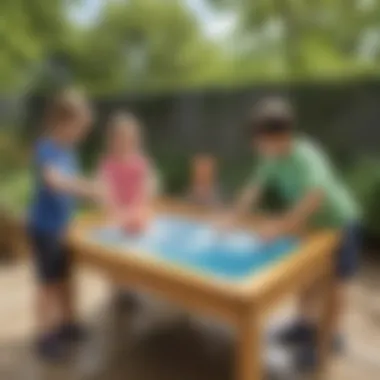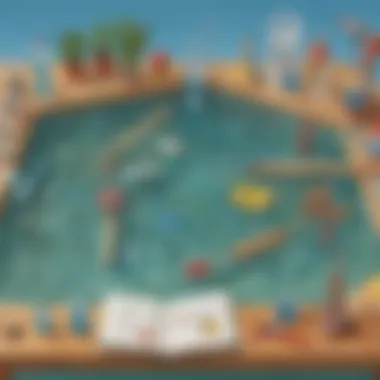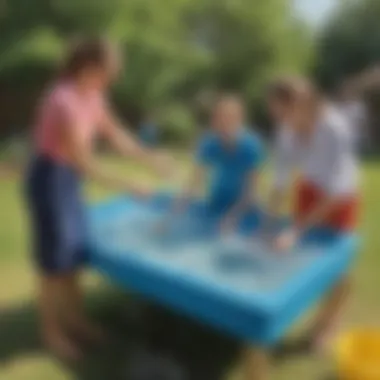Exploring Water Play Tables: Engaging Young Minds


Intro
Water play tables are more than just sources of fun for children; they are essential resources that foster early scientific inquiry and learning. Through hands-on exploration, young minds engage with fundamental scientific principles in an intuitive and captivating way. Whether designed for home use or educational settings, these tables encourage creativity, experimentation, and critical thinking among children aged six to twelve.
In this guide, we will discuss the various types of water play tables available, the key developmental skills that can be enhanced through water play, safety considerations to keep in mind, and practical tips to maximize the educational potential of these resources.
Science Fun Facts
Interesting Trivia and Facts
Water is unique. It is the only substance that exists naturally on Earth in three states: solid (ice), liquid (water), and gas (water vapor). This versatility is a key concept that can be explored through water play.
Quirky Science Stories
In ancient Rome, aqueducts delivered fresh water to its citizens. This remarkable engineering feat shows how important water has been throughout history. It can be eye-opening for children to understand how water driven innovation affects societies.
Amazing Science Records
According to the Guinness World Records, the largest water table was created in 2019 in the United Kingdom, measuring over 1,000 square feet! This showcases the scale possibilities of water play.
Thought-Provoking Questions
- Why does hot water freeze faster than cold water under certain conditions?
- What happens when you mix oil and water?
These questions can serve as discussion starters for young scientists during water play activities.
Discover the Wonders of Science
Exploring Various Scientific Concepts
Water play can introduce children to concepts such as buoyancy, density, and surface tension. Through simple experiments like floating objects or creating bubbles, kids can visualize these principles.
Educational Videos and Animations
When children see videos demonstrating principles of fluid dynamics, it can enhance their understanding. Websites such as Britannica offer a range of educational content that can complement hands-on learning.
Interactive Learning Tools
Augmented reality and educational apps can also enrich the experience. Tools that allow kids to see how different liquids interact can add another layer to their understanding of science.
Real-Life Applications of Science
Discussing everyday examples, such as the importance of clean water or the science behind weather patterns, can help children connect their experiences with learning.
Science Quiz Time
Interactive Quizzes
Creating quizzes based on water play tables can engage children during and after the activities, solidifying their learning.
Multiple Choice Questions
- What is the process of water turning into vapor called?
A) Evaporation
B) Condensation
C) Precipitation
Answer: A) Evaporation
Brain Teasers and Puzzles
Puzzles related to water cycles can be a fun way for children to learn while they enjoy play.
Learning Through Gamification


Incorporating game-like elements into water play can motivate children to learn and explore more effectively.
Science Experiment Showcase
Fun and Engaging Experiments
Children love to experiment! Some simple yet compelling experiments include:
- Creating a waterfall using plastic containers to illustrate gravity and flow.
- Making colored water with food coloring to observe mixing and diffusion.
Step-by-Step Instructions
- Fill a pot or bucket with water.
- Drop in various objects to see if they float or sink.
- Discuss the results with the children.
Materials List
- Plastic containers
- Water
- Food coloring
- Small objects (toys, kitchen items, etc.)
Safety Tips and Precautions
Always supervise children during water play. Ensure a non-slip surface around the play area and teach children to not drink the water used in play.
"Engaging in water play not only entertains children but also lays the groundwork for scientific thinking that will benefit them long into the future."
This guide integrates several elements of learning, allowing parents, educators, and caregivers to create an impactful, educational experience via water play tables.
Prolusion to Water Play Tables
Water play tables serve as more than mere playthings; they are essential educational tools for young minds. In the early stages of life, learning through play is crucial. These tables provide a unique platform for children to explore scientific concepts through hands-on experiences. The manipulation of water engages their senses and encourages inquiry, which is fundamental in fostering scientific thought.
Definition and Purpose
A water play table is a specialized container that holds water, typically designed for children to engage in various water-based activities. These tables can be filled with different items like toys, tools, or natural materials to encourage exploration. The primary purpose of water play tables is to create a stimulating environment where kids can experiment and discover the properties of water. They can learn about cause and effect, observe how objects float or sink, and understand basic concepts of buoyancy and density. Such activities align well with educational objectives in early childhood development.
History of Water Play in Education
Water play has been a component of educational practices for many years. The concept traces back to early childhood education in the mid-20th century, when educators recognized the importance of play in cognitive and social development. Initially, water play was seen as a way to keep children occupied; however, it evolved into a paradigm of active learning. Educators started integrating water play into structured learning environments to support scientific exploration.
Throughout history, various cultures have emphasized the role of water in learning. Notably, the Reggio Emilia approach, which originated in Italy, advocated for socially-driven play, including water experiences, as part of a child's education. Today, water play tables are widely used in preschool and kindergarten settings, creating a dynamic learning space that enriches children’s understanding of the world around them.
Types of Water Play Tables
The variety of water play tables available significantly enhances the educational experiences for children. Each type serves unique purposes that align with different learning styles and environments. Knowing the key characteristics of traditional, portable, and thematic water play tables is essential for parents and educators aiming to promote a rich learning environment.
Traditional Water Play Tables
Traditional water play tables are sturdy structures designed for outdoor or indoor use. They often come with various attachments such as funnels, scoops, and tubes, allowing children to experiment with water movement and flow. These setups encourage hands-on exploration. In this environment, children can gain a deeper understanding of physical concepts such as gravity and buoyancy. Moreover, these tables promote cooperative play. Children learn to share tools and ideas, fostering social skills.
"Water play facilitates not only scientific exploration but also enhances interpersonal connections among children."
The simplicity of traditional designs makes them accessible and effective. They can be easily incorporated into various learning themes, such as weather studies or animal habitats.
Portable Water Play Tables
Portable water play tables serve a flexible purpose. These tables are lightweight, allowing for easy transportation. This feature is beneficial for outdoor playdates, school events, or visits to local parks. Children can engage in water play in diverse environments, making the activity dynamic and exciting.
Setting up a portable water play table requires minimal effort, which means less time is spent on preparation and more time can be devoted to play. Some portable options come with built-in storage for toys and tools, maintaining organization and encouraging responsibility in children.
Another advantage is that most portable water tables are adaptable to different settings. They can easily transition from a backyard setting to a living room floor, providing continuous opportunities for learning.


Thematic and Interactive Water Play Tables
Thematic and interactive water play tables take learning a step further. These tables often incorporate specific themes, like ocean habitats or construction sites. This focused approach encourages kids to think critically about the world around them. For example, a table themed around an ocean habitat may include toy sea creatures, seaweed, and rocks. Children gain a chance to explore varying ecosystems while interacting with the elements around them.
Furthermore, some tables include interactive features like water pumps or spouts, which stimulate curiosity. Kids can control water flow and observe cause-and-effect relationships. The educational potential of thematic tables is vast, offering experiences that extend beyond just play. By relating play to real-world concepts, children may develop a stronger interest in environmental science and ecosystems.
Educational Benefits of Water Play
Water play tables serve more than just the purpose of entertaining children; they have significant educational benefits. Water play enhances learning experiences for young children while simultaneously nurturing critical skills. Through playful interactions with water, children engage in activities that promote a deeper understanding of various scientific concepts and social dynamics. As they explore, they develop cognitive, sensory, and social skills that are vital in their early years of development.
Scientific Exploration and Discovery
Understanding basic physics concepts
When children interact with water play tables, they intuitively grasp basic physics principles. They learn about buoyancy, motion, and flow through hands-on experiences. These concepts become tangible when kids experiment by submerging different objects. Water play serves as a real-world application of science.
One key characteristic of this exploration is that it takes learning beyond the classroom. It allows children to ask questions like "Why does this sink?" or "What happens when I pour water faster?" This method of inquiry leads to deeper understanding. Engaging with water in this way becomes an enjoyable process. It fosters a curiosity that encourages scientific thinking, a valuable skill for any young scientist.
Exploring the properties of water
The investigation of water's properties, such as surface tension and temperature changes, provides a fundamental understanding of science. Children discover how water can take different forms, whether liquid, solid, or gas. This kind of exploration also reveals practical applications, like the effects of heating water or freezing it.
A unique advantage of exploring these properties is the potential for integrated learning. Children can connect their findings from water play to real-life experiences and natural phenomena. Such interactions instill a sense of wonder and inquiry, key ingredients in fostering a love for science and discovery.
Enhanced Sensory Experiences
Visual and tactile stimulation
Water play tables provide rich visual and tactile experiences. As children splash, pour, and mix water with various materials, they observe colors and textures in motion. This sensory exploration not only captivates their attention but also aids in the development of fine motor skills.
The unique feature of sensory play is its ability to engage multiple senses simultaneously. This sensory richness is a beneficial aspect of water play that stimulates brain development. As children interact with different elements in the water, they hone their abilities to distinguish colors, shapes, and textures.
Encouraging creativity through play
Through water play, children's imaginations can run wild. They can create unique environments, whether by building structures with floating objects or orchestrating a miniature waterway. The act of creating allows them to express themselves fully.
Creativity is a key benefit of this process. It encourages children to think outside the box and devise solutions to problems encountered during play. For instance, when constructing their water features, kids might learn about engineering principles in a fun and accessible format.
Social Skills Development
Promoting teamwork and collaboration
Water play can be a social activity as much as an educational one. Children often work together to experiment with the water table, sharing tools and ideas. This collaboration fosters essential skills such as teamwork and negotiation.
This interactive aspect is characteristic of water play. It brings children together to achieve common goals. Whether they are trying to keep a boat afloat or create a dam, teamwork becomes integral to the experience.
Building communication skills
As children engage in collaborative play, they naturally practice and develop their communication skills. They describe their actions, ask questions, and articulate their thoughts. Effective communication is vital for any child's development.
The unique feature of this communication practice is that it occurs organically in a playful setting. Children learn to express their ideas while listening to others, establishing a foundation for strong interpersonal skills in the future.
Water play tables combine fun and learning, making them unique resources for nurturing young scientists. The benefits extend beyond just play. They serve as platforms for exploration and growth.
Safety Considerations
Safety is paramount when it comes to water play tables and the children who use them. As engaging as water play is for young scientists, careful planning is needed to avoid accidents and ensure a positive experience. Incorporating safety considerations means understanding the environment and maintaining precautions that allow exploration without unnecessary risk. This section focuses on the key elements to keep in mind.
Material Safety


The materials used in water play tables should be non-toxic and durable. These tables often feature plastic components, which should be free from harmful chemicals like BPA or phthalates. Parents and educators must check for marks or certifications indicating material safety. Using high-quality materials not only enhances the longevity of the table but also reduces the risk of chemical exposure for children.
Regular inspection of the water play table is essential. Cracks and sharp edges may develop over time, posing hazards to children's safety. Ensuring all materials are safe, smooth, and appropriate for young children helps provide a safe environment for learning.
Supervision Requirements
Supervision is crucial during water play activities. Even shallow water can present risks for young children. An attentive adult can quickly react to any unexpected situations. It is advisable to have a responsible adult observe the water play area at all times. This applies not only for safety concerns but also to support child engagement and interaction.
When organizing playtime, it is beneficial to set a ratio of students to adults. For example, having one adult for every three to five children can allow for effective monitoring. Strong leadership ensures not just safety, but also enhances the educational experience by guiding scientific exploration while keeping children engaged.
Hygiene Practices
Hygiene cannot be overlooked when considering water play. Standing water can quickly become a breeding ground for bacteria. Regular changes of water and cleaning of the play tables will prevent this issue. Washable toys and tools used in the tables should be cleaned frequently to support hygienic play.
In addition to maintaining the water's cleanliness, teaching children about proper hygiene, such as handwashing before and after play, is essential. This encourages a healthy mindset that accompanies the educational benefits of water play. Instilling these practices early can foster long-term healthy habits for children.
“Safety is not just a priority; it is a core element of a successful learning experience.”
Tips for Maximizing Educational Potential
Maximizing the educational potential of water play tables is essential for promoting curiosity, creativity, and learning in young children. Water play offers more than just enjoyment; it serves as an interactive platform for science education. Engaging children in meaningful activities can enhance their understanding of natural phenomena and encourage critical thinking. Therefore, caregivers and educators should adopt strategies that leverage water play tables effectively in various settings.
Incorporating Scientific Questions
Asking scientific questions during water play is vital for fostering a sense of inquiry among children. Questions should be open-ended and tailored to stimulate thinking. Instead of simply observing or playing, adults can invite children to explore concepts like:
- What happens when we add salt to water?
- How can we change the shape of water using different containers?
- What floats and what sinks, and why?
Incorporating these questions leads to discussions, experimentation, and observations, which are core components of the scientific method. Encouraging children to ask their own questions nurtures their curiosity and allows for deeper engagement with their surroundings.
Setting Up Structured Activities
While free play is beneficial, structured activities can sharpen focus and guide learning. Creating plans that include specific tasks can reinforce learning objectives. Consider activities like:
- Water Cycle Experiment: Using jars, they can model evaporation and condensation.
- Sink or Float Challenge: Gather various items and record predictions and outcomes.
- Building Structures: Encourage children to construct boats or bridges and test their durability.
These exercises enhance understanding of physical laws and reinforce problem-solving skills. By providing clear objectives and allowing exploration through guided activities, children can develop resilience and adaptability.
Utilizing Natural Elements
Integrating natural elements into water play can enrich the sensory experience while teaching crucial environmental awareness. Elements such as leaves, stones, or flower petals can add depth to experiments. Using natural items:
- Helps children understand ecosystems and biodiversity.
- Encourages discussions about nature and its wonders.
- Fosters appreciation for the environment.
For instance, placing stones of different shapes and sizes in water can lead to exploration of buoyancy and weight. It can also lead to conversations about how different materials interact with water in real-world scenarios. This not only enhances scientific learning but develops a sense of responsibility toward nature.
Incorporating natural elements allows children to connect science with their everyday lives, grounding technical understanding in relatable experiences.
Culmination
The conclusion serves as a critical reflection on the significant role water play tables hold in childhood education. They are not only tools for entertainment; they facilitate a deeper exploration of scientific concepts in a hands-on manner. Water play tables encourage children to experiment with water, enabling them to grasp essential ideas related to physics, such as buoyancy, flow, and volume.
The Role of Water Play in Learning
Water play integrates scientific inquiry with observable phenomena, making abstract concepts more tangible for young learners. Engaging with water through direct interaction enhances cognitive development, allowing children to form hypotheses and draw conclusions based on their experiences. This form of experiential learning is particularly valuable because it actively involves children in their education. They experience results in real-time, leading to a more profound understanding of the world around them.
Moreover, water play promotes sensory exploration. It stimulates visual and tactile senses that are crucial for young children's development. Activities like pouring, splashing, and mixing different materials encourage fine motor skills and hand-eye coordination. Children learn to differentiate textures, colors, and temperatures through various water-related activities, thus enhancing their observational skills and critical thinking.
Encouragement for Parents and Educators
Parents and educators play a vital role in maximizing the benefits of water play tables. They should curate experiences that are not only fun but educational. It is essential to incorporate open-ended questions during play to stimulate children’s curiosity. For example, asking questions like "What happens when you mix water with sand?" or "How can we move water from one spot to another?" will encourage children to think critically about their actions.
Additionally, creating structured activities can enhance learning outcomes significantly. By guiding children towards specific tasks, educators can focus on scientific principles while ensuring engagement. This method of guided discovery helps in reinforcing learning through practical applications.
Finally, it is essential to maintain an environment that upholds safety and hygiene standards. Regular monitoring during playtime ensures children are safe while using the water play tables, which is paramount. Encouragement from parents and educators in this context can lead to a fruitful exploration of science, nurturing young scientists while they learn through play.







